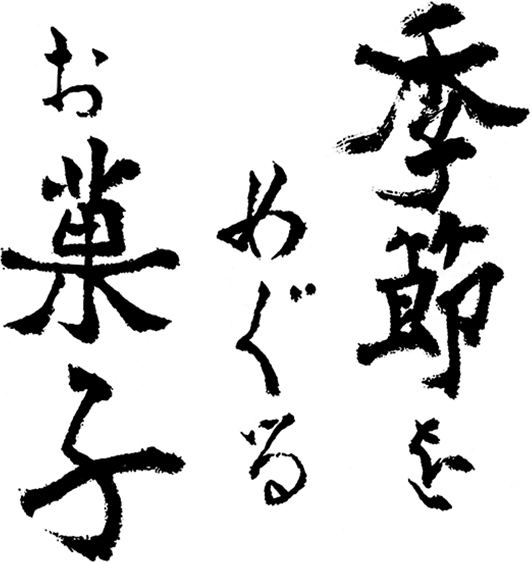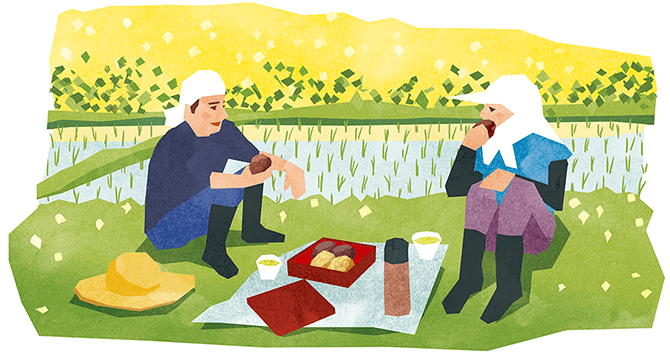 Confectionsfor All Seasons
Confectionsfor All Seasons
Spring / About the confections and their origins
“The spirit of the season
in the village”

Omi’s calendar is marked
by rice fields
Rising from the melted snow, yellow flowers of Adonis herald the arrival of spring. Not only flowers, but also edible wild plants begin to thrive. Nowadays these plants are grown in greenhouses, but once they grew wild in the fields, and people competed to gather them.
As the days of spring get sunnier, after cutting the ears of rice and when the shoots begin to sprout, the farmers begin to prepare the soil for the paddy field. In Omi, in ancient times, rice cultivation was a central activity which kept people busy all year round. Farmers have now replaced oxen and horses with machinery, but rice cultivation continues to keep the locals busy to a large extent.
In March, horsetails grow between the ridges of the rice fields. During their childhood, many people gathered them and, once they returned home, helped their parents to boil and cook them. In the same month, while the soil for the paddy field is being prepared, reeds are burned on the shores of Lake Nishinoko. The flames rising from the dry reeds kill the harmful insects present in the soil, and the remaining ash becomes an excellent fertilizer for the new reeds that will grow.
Neighbors helping
each other
Then the enchanting cherry blossom season begins. After a while, just as the mountain cherry trees begin to lose their petals, different type of trees around them begin to sprout in unison. That green sea of leaves becomes lusher with each passing day. Finally, it is when the rice fields are flooded with water that spring really arrives. Seeing the blue sky reflected in the water of the rice fields is a spring element typical of this region.
May is the month of rice planting. Today it is a mechanized process, but in the past, it took many people in order to do it. People from the same community helped each other, and they could take no rest until each paddy field was ready. During their breaks from work, they used to drink tea together on the ridges between rice fields, and at noon they enjoyed the lunch that had been prepared for them. Of course, there were also confections such as kusamochi (made using Japanese mugwort) or botamochi.
It was a very tiring job, which required a lot of physical effort. For this reason, once they had finished planting the rice, people had banquets called sanaburi and went to the onsen (hot spring baths) to relax. Immersed in hot water, they could find the strength to help with the weeding over the next few days. Having sanaburi banquets and going to the onsen are traditions that still exist today.
The numerous matsuri (festivals) are
the symbol of the village
Once the rice has been planted,
the shoots swaying in the wind
paint the spring landscape and
the whole village with beauty.
The fields will continue changing their appearance until harvest in autumn, coloring the village with new colors each time.
Rice farming remains tough work even with the help of tractors and machinery. A large workforce is needed, and between one farming task and another the local people still organize Shinto rituals and matsuri (festivals) today, such as the “fire festivals” Sagicho matsuri and Hachiman matsuri, two symbolic festivals where people pray to have a bountiful harvest.
Taneya, as if to respond to the call of spring, has created numerous kinds of sweets. In particular, organic yomogi (Japanese mugwort) grown at Eigenji is used to make different mochi (rice cakes) and manju (steamed buns). In ancient times, men incorporated Omi’s nature and seasons into their daily life; nowadays, albeit in a different form, Taneya does the same thing.